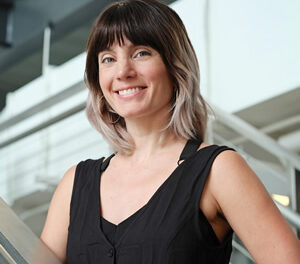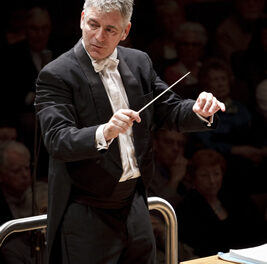The month of December had arrived, so even the most curmudgeonly could scarcely complain that the Christmas celebration in Jones Auditorium on the Meredith College campus was premature. When conductor Jim Waddelow launched the Raleigh Symphony Orchestra players into Haydn’s Symphony No. 30, the audience might well have suspected a mistake. What did that piece have to do with Christmas? But it was subtitled “Alleluia,” and it constituted a lively warm-up for players and listeners alike. The slow middle movement gave the flutes and the other woods a chance to demonstrate excellent technique. Waddelow kept the work moving at a dynamic clip that would have pleased Papa Haydn.
The program notes pointed out that the American composer/critic William Henry Fry had “interviewed Hector Berlioz in 1852.” Those notes might also have conjectured that he probably garnered a few hints from his more famous French contemporary. The sound effects and orchestration in Fry’s Santa Claus: Christmas Symphony (1853) were so evocative of Berlioz’s Symphonie Fantastique that one readily made the connection. Again from the notes: “The themes…include the opening fanfare to announce the birth of the Savior; a family party to celebrate Christmas; putting the children to bed…” Cornet, saxophone, bassoon and flutes get into the act. Death is even treated with a lugubrious double bass solo turn (Berlioz’s “March to the Scaffold”?). This improbable, uncommon but altogether delightful work was authoritatively conducted by local musician and educator John Randal Guptill. Conductor and players seemed “at home” and comfortable with this huge half-hour selection.
The second of Waddelow’s “helpers” made two appearances during the evening. Baritone DeMar Neal’s initial set of songs were unremarkable renditions of “I Heard the Bells on Christmas Day” and “The First Noel,” arranged by Waddelow and violinist Emily McLawhorn, respectively. The latter orchestration ranged from a spare pianissimo to a more vigorous forte.
Neal hit his stride as a veritable crooner in the closing set of three timeless Christmas favorites. (To you of a certain age, think Dick Haymes.) His satiny baritone was devoid of distracting idiosyncrasies and excessive vibrato. Thanks to Waddelow’s arrangement of the great Frank Loesser song, he asked the lady, “What Are You Doing New Year’s Eve?” Pianist Katherine Barton assisted in arranging “Silver Bells” and “White Christmas.” Neal enhanced these standbys with the inclusion of the “preludes,” those meaningful introductory sections that are so consistently omitted. Come to think of it, you could also discern a touch of foggy Mel Torme in his interpretations. (Let us pause a moment in colossal thanks for such bygone gems as these selections. A latter-day Irving Berlin would dream of a “White Holiday Season.”)
Capping their consistently fine quality with an encore, the players once again proved that you cannot stage such a program without a spirited reading of Leroy Anderson’s “Sleigh Ride.” Anecdotally, the evening can be declared a success in yet another respect. One departing patron was heard resolving now to go home and start with Christmas decorations.












